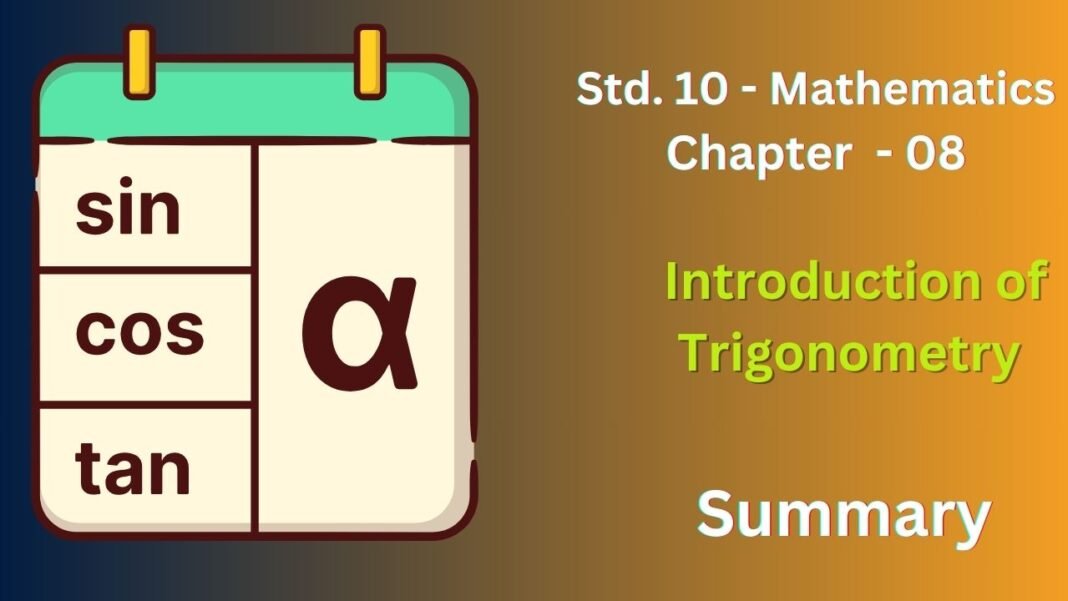The word “trigonometry” is derived from the Greek words “tri” (meaning three), “gon” (meaning sides), and “metron” (meaning measure).
Key Concepts:
- Trigonometric Ratios: These are ratios of the sides of a right-angled triangle with respect to its acute angles.
- Trigonometric Identities: These are equations involving trigonometric ratios that hold true for all values of the angle involved.
- Trigonometric Tables: These tables provide the values of trigonometric ratios for different angles.
Applications of Trigonometry:
Trigonometry has wide-ranging applications in various fields, including:
- Surveying
- Navigation
- Engineering
- Physics
- Astronomy
In essence, trigonometry provides a mathematical framework for understanding and analyzing geometric relationships, especially in triangles.
Exercise 8.1
1. In ∆ABC right angled at B, AB = 24 cm, BC = 7 cm. Determine:
(i) sin A, cos A
(ii) sin C, cos C
Ans :
Step 1: Find the hypotenuse AC Using the Pythagorean theorem: AC² = AB² + BC² AC² = 24² + 7² AC² = 576 + 49 AC² = 625 AC = 25 cm
Step 2: Find the trigonometric ratios (i) sin A, cos A
- sin A = opposite side / hypotenuse = BC / AC = 7/25
- cos A = adjacent side / hypotenuse = AB / AC = 24/25
(ii) sin C, cos C
- sin C = opposite side / hypotenuse
- = AB / AC = 24/25
- cos C = adjacent side / hypotenuse
- = BC / AC = 7/25
2. In given figure, find tan P – cot R.
Ans :
3. If sin A = 3/4 , calculate cos A and tan A.
Ans :
Using the Pythagorean Identity:
- sin²A + cos²A = 1
Substituting the given value of sin A:
- (3/4)² + cos²A = 1
- 9/16 + cos²A = 1
- cos²A = 1 – 9/16
- cos²A = 7/16
- cos A = ±√(7/16)
Since we are dealing with an angle in a right-angled triangle, cosine is positive. Therefore, cos A = √7/4
Finding tan A:
- tan A = sin A / cos A = (3/4) / (√7/4) = 3/√7
4. Given 15 cot A = 8, find sin A and sec A.
Ans :
Given: 15 cot A = 8 Therefore, cot A = 8/15
We know that:
- cot A = base/perpendicular = B/P
- So, let base (B) = 8k and perpendicular (P) = 15k, where k is a positive constant.
Using Pythagoras theorem:
- Hypotenuse (H)² = Base² + Perpendicular²
- H² = (8k)² + (15k)²
- H² = 64k² + 225k²
- H² = 289k²
- H = 17k
Find sin A and sec A:
- sin A = perpendicular/hypotenuse = P/H = 15k/17k = 15/17
- sec A = hypotenuse/base = H/B = 17k/8k = 17/8
5. Given sec θ = 13/12 , calculate all other trigonometric ratios.
Ans :
Given: sec θ = 13/12
We know that:
- sec θ = hypotenuse / base
Therefore, hypotenuse = 13 and base = 12.
Using Pythagoras theorem to find the perpendicular:
- hypotenuse² = perpendicular² + base²
- 13² = perpendicular² + 12²
- perpendicular² = 169 – 144 = 25
- perpendicular = 5
Now, we can find the other trigonometric ratios:
- sin θ = perpendicular / hypotenuse
- = 5/13
- cos θ = base / hypotenuse = 12/13
- tan θ = perpendicular / base = 5/12
- cot θ = base / perpendicular = 12/5
- cosec θ = hypotenuse / perpendicular = 13/5
6. If ∠A and ∠B are acute angles such that cos A = cos B, then show that ∠A = ∠B.
Ans :
Consider a right-angled triangle ABC with ∠C = 90°.
- cos A = BC/AC (adjacent side/hypotenuse)
- cos B = AC/AB (adjacent side/hypotenuse)
Given that cos A = cos B, we have:
- BC/AC = AC/AB
Cross-multiplying, we get:
- BC * AB = AC * AC
- BC * AB = AC²
Now, consider the same triangle ABC.
- By the Pythagorean theorem, we have:
- AB² = AC² + BC²
Substitute BC * AB for AC² from the previous equation:
- AB² = BC * AB + BC²
- AB² – BC * AB – BC² = 0
- (AB – BC)(AB + BC) = 0
Since AB and BC are lengths of sides of a triangle, they cannot be negative. Therefore, AB + BC ≠ 0.
Hence, AB – BC = 0
- AB = BC
In triangle ABC, since AB = BC, the angles opposite to these equal sides are also equal.
Therefore, ∠A = ∠B.
7. If cot θ = 7/8, evaluate:
(i) (1+sinθ)(1−sinθ)/(1+cosθ)(1−cosθ)
(ii) cot²θ
Ans :
(i) Evaluating (1+sinθ)(1-sinθ) / (1+cosθ)(1-cosθ)
Using the identity (a+b)(a-b) = a²-b², we get:
- Numerator = (1+sinθ)(1-sinθ) = 1 – sin²θ
- Denominator = (1+cosθ)(1-cosθ) = 1 – cos²θ
Using the Pythagorean identity sin²θ + cos²θ = 1, we get:
- Numerator = cos²θ
- Denominator = sin²θ
Therefore, the expression becomes:
- cos²θ / sin²θ = (cosθ/sinθ)²
Since cot θ = cosθ/sinθ, we have:
- (cosθ/sinθ)² = cot²θ
Now, we know cot θ = 7/8, so cot²θ = (7/8)² = 49/64.
Therefore, the value of the expression is 49/64.
8. If 3 cot A = 4, check whether 1−tan2A/1+tan2A = cos² A – sin² A or not.
Ans :
Given: 3 cot A = 4
Step 1: Find tan A
- cot A = 4/3
- tan A = 1/cot A = 3/4
Step 2: Evaluate the Left Hand Side (LHS)
- LHS = (1 – tan²A) / (1 + tan²A) = (1 – (3/4)²) / (1 + (3/4)²) = (1 – 9/16) / (1 + 9/16) = (7/16) / (25/16) = 7/25
Step 3: Evaluate the Right Hand Side (RHS)
- RHS = cos²A – sin²A
To find cos A and sin A, we can use the Pythagorean identity:
- tan²A + 1 = sec²A
- (3/4)² + 1 = sec²A
- sec²A = 25/16
- sec A = 5/4
Now, cos A = 1/sec A = 4/5 And sin A = √(1 – cos²A) = √(1 – (16/25)) = 3/5
Therefore, RHS = (4/5)² – (3/5)² = 16/25 – 9/25 = 7/25
Since LHS = RHS, the given equation is true.
Hence, (1 – tan²A) / (1 + tan²A) = cos²A – sin²A.
9. In triangle ABC, right angled at B, if tan A = 1/√3, find the value of:
(i) sin A cos C + cos A sin C
(ii) cos A cos C – sin A sin C
Ans :
Step 1: Find sin A and cos A
Given tan A = 1/√3
We know that tan A = perpendicular/base = BC/AB
So, let BC = k and AB = √3k
Using Pythagoras theorem, AC = 2k
Therefore, sin A = BC/AC = k/2k = 1/2
And cos A = AB/AC = √3k/2k = √3/2
Step 2: Find the values of sin C and cos C
Since ∠B = 90°, ∠A + ∠C = 90°
So, if tan A = 1/√3, then ∠A = 30°
Therefore, ∠C = 60°
sin C = sin 60° = √3/2
cos C = cos 60° = 1/2
Step 3: Evaluate the expressions
(i) sin A cos C + cos A sin C = (1/2)(1/2) + (√3/2)(√3/2) = 1/4 + 3/4 = 1
(ii) cos A cos C – sin A sin C = (√3/2)(1/2) – (1/2)(√3/2) = 0
10. In ΔPQR, right-angled at Q, PR + QR = 25 cm and PQ = 5 cm. Determine the values of sin P, cos P and tan P.
Ans :
Step 1: Find the lengths of PR and QR Let QR = x cm. Then, PR = (25 – x) cm.
Using the Pythagorean theorem in right-angled triangle PQR:
- PQ² + QR² = PR²
- 5² + x² = (25 – x)²
- 25 + x² = 625 – 50x + x²
- 50x = 600
- x = 12
So, QR = 12 cm and PR = 25 – 12 = 13 cm.
Step 2: Find the trigonometric ratios
- sin P = opposite side / hypotenuse = QR/PR = 12/13
- cos P = adjacent side / hypotenuse = PQ/PR = 5/13
- tan P = opposite side / adjacent side
- = QR/PQ = 12/5
11. State whether the following statements are true or false. Justify your answer.
(i) The value of tan A is always less than 1.
(ii) sec A = 12/5 for some value of angle A.
(iii) cos A is the abbreviation used for the cosecant of angle A.
(iv) cot A is the product of cot and A.
(v) sin θ = 4/3 for some angle.
Ans :
(i) False.
- The value of tan A can be less than, greater than, or equal to 1. It depends on the values of the opposite side and adjacent side of the right-angled triangle.
(ii) True.
- sec A is the reciprocal of cos A. Since cos A can take values between -1 and 1 (excluding 0), sec A can be greater than 1. Hence, sec A = 12/5 is possible for some angle A.
(iii) False.
- cos A is the abbreviation for cosine of angle A, while cosec A is the abbreviation for cosecant of angle A.
(iv) False.
- cot A is the cotangent of angle A, not the product of cot and A.
(v) False.
- The value of sin θ always lies between -1 and 1. Since 4/3 is greater than 1, it cannot be the value of sin θ for any angle θ.
Exercise 8.2
1. Evaluate the following:
Ans :
Expression (i):
sin 60° cos 30° + sin 30° cos 60°
= (√3/2 * √3/2) + (1/2 * 1/2)
= 3/4 + 1/4
= 1
Expression (ii):
2 tan² 45° + cos² 30° – sin² 60°
= 2 * (1)² + (√3/2)² – (√3/2)²
= 2 + 3/4 – 3/4
= 2
Expression (iii):
cos 45° / (sec 30° + cosec 30°)
= (1/√2) / (2/√3 + 2)
= (1/√2) / (2(1 + √3)/√3)
= √3 / (2√2 * (1 + √3))
Rationalizing the denominator:
= √3 / (2√2 * (1 + √3)) * (√2 – √6) / (√2 – √6)
= (√6 – √18) / (4 * (1 – 3))
= (√6 – 3√2) / (-8)
= (3√2 – √6) / 8
Expression (iv):
(sin 30° + tan 45° – cosec 60°) / (sec 30° + cos 60° + cot 45°)
= (1/2 + 1 – 2) / (2/√3 + 1/2 + 1)
= -1/2 / (2/√3 + 3/2)
= -1/2 / ((4 + 3√3)/2√3)
= -√3 / (4 + 3√3)
Rationalizing the denominator:
= -√3 / (4 + 3√3) * (4 – 3√3) / (4 – 3√3)
= (-4√3 + 9) / (16 – 27)
= (9 – 4√3) / (-11)
Expression (v):
(5 cos² 60° + 4 sec² 30° – tan² 45°) / (sin² 30° + cos² 30°)
= (5 * (1/2)² + 4 * (2/√3)² – (1)²) / ((1/2)² + (√3/2)²)
= (5/4 + 16/3 – 1) / (1/4 + 3/4)
= (15 + 64 – 12) / 12
= 67 / 12
2. Choose the correct option and justify your choice:
Ans :
3. If tan (A + B) = √3 and tan (A – B) = 1/√3; 0° < A + B ≤ 90°; A > B, find A and B.
Ans :
Step 1: Identify the angles from the given tangent values
We know that:
- tan 60° = √3
- tan 30° = 1/√3
Therefore,
- tan(A+B) = tan 60°
- tan(A-B) = tan 30°
Step 2: Equate the angles From the above equations, we can deduce that:
- A + B = 60° (Equation 1)
- A – B = 30° (Equation 2)
Step 3: Solve the equations Adding equations (1) and (2):
- 2A = 90°
- A = 45°
Substituting A = 45° in equation (1):
- 45° + B = 60°
- B = 15°
4. State whether the following statements are true or false. Justify your answer.
(i) sin (A + B) = sin A + sin B.
(ii) The value of sin θ increases as θ increases.
(iii) The value of cos θ increases as θ increases.
(iv) sin θ = cos θ for all values of θ.
(v) cot A is not defined for A = 0°.
Ans :
(i) False.
This is not a trigonometric identity. The correct expansion for sin(A + B) involves both sine and cosine terms.
(ii) True.
The value of sin θ increases as θ increases from 0° to 90°. However, it decreases as θ increases from 90° to 180°.
(iii) False.
The value of cos θ decreases as θ increases from 0° to 90°.
(iv) False.
This equality holds true only for θ = 45°. In general, sin θ and cos θ are different functions with different values for most angles.
(v) True.
cot A = cos A / sin A. Since sin 0° = 0, cot 0° becomes undefined.
Exercise 8.3
1. Express the trigonometric ratios sin A, sec A and tan A in terms of cot A.
Ans :
1. Expressing sin A in terms of cot A:
We know that:
- cot A
- = cos A / sin A
- cot²A = cos²A / sin²A
Using the Pythagorean identity, sin²A + cos²A = 1, we can write:
- cot²A = (1 – sin²A) / sin²A
- cot²A * sin²A = 1 – sin²A
- sin²A (1 + cot²A) = 1
- sin²A = 1 / (1 + cot²A)
- sin A = 1 / √(1 + cot²A)
2. Expressing sec A in terms of cot A:
We know that:
- sec²A = 1 + tan²A
Substituting tan A = 1/cot A:
- sec²A = 1 + (1/cot²A)
- sec²A = (cot²A + 1) / cot²A
- sec A = √(cot²A + 1) / cot A
Therefore, sec A = √(cot²A + 1) / cot A
3. Expressing tan A in terms of cot A:
We know that:
- tan A = 1 / cot A
Therefore, tan A = 1 / cot A
2. Write all the other trigonometric ratios of ∠A in terms of sec A.
Ans :
Given: sec A = 1/cos A
1. Finding sin A:
- Using the Pythagorean identity: sin²A + cos²A = 1
- sin²A = 1 – cos²A
- sin²A = 1 – (1/sec A)²
- sin A = √(1 – 1/sec²A)
2. Finding tan A:
- tan A
- = sin A / cos A
- tan A = √(1 – 1/sec²A) / (1/sec A)
- tan A = sec A * √(1 – 1/sec²A)
3. Finding cot A:
- cot A = 1 / tan A
- cot A = 1 / (sec A * √(1 – 1/sec²A))
- cot A = √(1 – 1/sec²A) / sec A
4. Finding cosec A:
- cosec A = 1 / sin A
- cosec A = 1 / √(1 – 1/sec²A)
3. Choose the correct option. Justify your choice.
(i) 9 sec² A – 9 tan² A = ……
(A) 1
(B) 9
(C) 8
(D) 0
(ii) (1 + tan θ + sec θ) (1 + cot θ – cosec θ) = ………..
(A) 0
(B) 1
(C) 2
(D) -1
(iii) (sec A + tan A) (1 – sin A) = ………….
(A) sec A
(B) sin A
(C) cosec A
(D) cos A
(iv) 1+tan2A/1+cot2A = ………..
(A) sec² A
(B) -1
(C) cot² A
(D) tan² A
Ans :
4. Prove the following identities, where the angles involved are acute angles for which the expressions are defined.
Ans :









